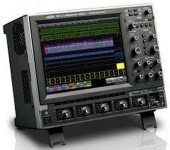22 Lý Tự Trọng, Minh Khai, Hồng Bàng, Hải Phòng.
itvc.haiphong@itvc-global.com
Chi tiết sản phẩm
Manufacturer: Teledyne LeCroy - USA
Model:WaveRunner 64Xi-A
Analog Bandwidth:600 MHz
Single-Shot Sample Rate/Ch:5GS/s
Input Channels:4
Color 10.4" flat-panel TFT-LCD with high resolution touch screen
The Teledyne LeCroy WaveRunner Xi-A is the most powerful and capable scope available in its class. Basic system validation using advanced triggers, fast viewing modes, measurement parameters, or serial decodes is simple and easy. Advanced debug, multi-domain analysis, and waveshape analysis are possible with tools unique to WaveRunner Xi-A. Optional application packages help you make sense of well-defined problems.
Trigger on I2C, SPI, UART, RS-232, AudioBus (I2S, LJ, RJ, TDM), LIN, CAN, or FlexRay or MIL-STD-1553 serial data patterns. Intuitively decode values on the oscilloscope grid.
An extensive collection of SMART, Serial, and Digital (MS Series) triggers enables users to quickly and easily isolate events of interest (some optional).
Use the high sampling rate and WaveStream fast viewing mode to characterize signal shape, rise time, overshoot, etc., and verify the presence or absence of high-speed transients.
Sequence Mode allows you to partition your acquisition memory into segments and capture specific events over long periods of time. Then, view and analyze each segment individually.
Search and Analysis WaveScan provides the ability to locate unusual events in a single capture, or scan for an event in many acquisitions over a long period of time using more than 20 different search/scan modes. Use ScanHisto or ScanOverlay to display intuitive scanned results.
Quickly create your own measurement parameters or math functions using Excel, MATLAB®, or VBScripts (some capability optional).
Use a variety of application packages to provide detailed, fast solutions for specific problems.
WaveRunner Xi-As long memory is optimized for calculation of more information 10–100x faster than other oscilloscopes, while enabling easy access to simple zooming and positioning from the front panel.
More standard and optional measurements and more powerful math capability are provided with results returned faster than in other oscilloscopes.
Amplify your understanding with multidomain analysis of your signals. Convert signal information into Statistical domain (Histogram), Spectral domain (long memory FFTs), Jitter, Modulation, or other Measurement Parameter domains (Tracks of measurement parameters). (Some capability is optional.)
Teledyne LeCroy math, measure, and analysis tools are tightly integrated with basic scope operations. Its easy to link capabilities and expand understanding. Free yourself from constraints!
A wide variety of active FET probes, current probes, differential probes, HV probes, etc. with complete tip and ground accessories make it easy to probe your signals.
The MS Series can capture digital signals with speeds up to 500 MHz. View up to 36 digital channels with up to 50 Mpts/Ch memory and analyze analog and digital events together.
Excellent overdrive recovery and signal integrity make WaveRunner Xi-A ideal for high-voltage switching loss, conduction loss, ripple, switching power supply, and other amplifier measurements. Use with Teledyne LeCroy Differential Amplifiers for highperformance 100,000:1 Common Mode Rejection Ratio.
Extensive triggers allow fast event isolation. Measure timing statistically and view behavior graphically using histograms. Gain real understanding of root cause.
Long memory, HFREJ trigger coupling, built-in noise filtering, etc. enable fast understanding of signal behavior in circuits with a mix of slow-speed (sensor, actuator, power supply, mechanical) and high-speed signals.
Vertical System |
|
| Analog (ProBus Input) Bandwidth @ 50 Ω (-3 dB) | 600 MHz (Nominal, 10 mV-1 V/div) |
| Analog (ProBus Input) Bandwidth @ 1 MΩ (-3 dB) | 500 MHz (typical) |
| Rise Time (10–90%) | 500 ps |
| Input Channels | 4 |
| Bandwidth Limiters | 20 MHz, 200 MHz |
| Input Impedance | 50 Ω+/-1% or 1 MΩ||16pF, 10 MΩ || 16 pF with supplied Probe |
| Input Coupling | 1 MΩ: AC, DC, GND; 50 Ω: DC, GND |
| Maximum Input Voltage |
50 Ω: ±5 Vrms 1 MΩ: 400 V max. (DC + peak AC < 5 kHz) |
| Vertical Resolution | 8 bits; up to 11 bits with enhanced resolution (ERES) |
| Sensitivity | 50 Ω: 2 mV–1 V/div, fully variable; 1 MΩ: 2 mV–10 V/div, fully variable |
| DC Gain Accuracy | ±1.0% of full scale (typical); ±1.5% of full scale, ≥10 mV/div (guaranteed) |
| Offset Range |
50 Ω: ±1 V @ 2–98 mV/div ±10 V @ 100 mV/div -1 V/div 1 MΩ: ±1V @ 2–98 mV/div ±10V @ 100mV-1 V/div ±100V @ 1.02V-10V/div |
| Offset Accuracy | ±(1.5% of offset value +0.5% of full scale +1mV) |
Horizontal System |
|
| Timebases | Internal timebase common to 4 input channels; an external clock may be applied at the auxiliary input |
| Time/Division Range | Real-Time: 200 ps/div–10 s/div; RIS mode: 200 ps/div - 10 ns/div; Roll mode: up to 1000 s/div (roll mode is user selectable at ≥100 ms/div and ≤5 MS/s |
| Clock Accuracy | ≤ 5 ppm @ 25°C (typical) (≤ 10 ppm @ 5-40°C ) |
| Time Interval Accuracy | < 0.06 / SR + (clock accuracy* Reading) (rms) |
| Sample Rate and Delay Time Accuracy | Equal to Clock Accuracy |
| Trigger and Interpolator Jitter | ≤ 3 psrms (typical) |
| Channel-Channel Deskew Range | ±9 x time/div. setting, 100 ms max., each channel |
Acquisition System |
|
| Single-Shot Sample Rate/Ch |
5 GS/s on 4 Ch 10 GS/s on 2 Ch |
| Random Interleaved Sampling (RIS) | 200 GS/s, user selectable for repetitive signals (200 ps/div to 10 ns/div) |
| Maximum Trigger Rate | 1,250,000 waveforms/second (in Sequence Mode, up to 4 channels) |
| Intersegment Time | 800 ns |
| Standard Memory (4 Ch / 2 Ch / 1Ch) (Number of Segments) |
12.5 M / 25 M / 25M (10,000) |
Acquisition Processing |
|
| Averaging | Summed averaging to 1 million sweeps; continuous averaging to 1 million sweeps |
| Enhanced Resolution (ERES) | From 8.5 to 11 bits vertical resolution |
| Envelope (Extrema) | Envelope, floor, or roof for up to 1 million sweeps |
| Interpolation | Linear or Sin x/x |
Triggering System |
|
| Modes | Normal, Auto, Single, and Stop |
| Sources | Any input channel, Ext, Ext/10, or line; slope and level unique to each source (except line trigger) |
| Coupling Mode | DC, AC (typically 7.5 Hz), HFRej, LFRej |
| Pre-trigger Delay | 0–100% of memory size (adjustable in 1% increments of 100 ns) |
| Post-trigger Delay | 0–10,000 divisions in real time mode, limited at slower time/div settings or in roll mode |
| Hold-off by Time or Events | From 1 ns up to 20 s or from 1 to 1,000,000,000 events |
| Internal Trigger Range | ±4.1 div from center (typical) |
| Trigger Sensitivity with Edge Trigger ProBus Inputs |
2 div @ < 600 MHz 1 div @ < 200 MHz (DC, AC, and LFRej coupling) |
| External Trigger Sensitivity, (Edge Trigger) |
2 div @ < 600 MHz 1 div @ < 200 MHz (DC, AC, and LFRej coupling) |
| Max. Trigger Frequency, SMART Trigger | 600 MHz @ ≥ 10 mV/div |
| External Trigger Input Range | Ext (±0.4 V); Ext/10 (±4 V) |
Basic Triggers |
|
| Edge | Triggers when signal meets slope (positive, negative, or either) and level condition. |
| Window | Triggers when signal exits a window defined by adjustable thresholds |
| TV-Composite Video | Triggers NTSC or PAL with selectable line and field; HDTV (720p, 1080i, 1080p) with selectable frame rate (50 or 60 Hz) and Line; or CUSTOM with selectable Fields (1-8), Lines (up to 2000), Frame Rates (25, 30, 50, or 60 Hz), Interlacing (1:1, 2:1, 4:1, 8 |
SMART Triggers |
|
| State or Edge Qualified | Triggers on any input source only if a defined state or edge occurred on another input source. Delay between sources is selectable by time or events. |
| Qualified First | In Sequence acquisition mode, triggers repeatably on event B only if a defined pattern, state, or edge (event A) is satisfied in the first segment of the acquisition. Holdoff between sources is selectable by time or events. |
| Dropout | Triggers if signal drops out for longer than selected time between 1 ns and 20 s. |
| Pattern | Logic combination (AND, NAND, OR, NOR) of 5 inputs (4 channels and external trigger input, or 2 channels and external input for 62Xi). Each source can be high, low, or don’t care. The High and Low level can be selected independently. Triggers at start o |
SMART Triggers with Exclusion Technology |
|
| Glitch | Triggers on positive or negative glitches with widths selectable as low as 500ps (depending on oscilloscope bandwidth) to 20 s, or on intermittent faults. |
| Width (Signal or Pattern) | Triggers on positive or negative glitches with widths selectable as low as 500ps (depending on oscilloscope bandwidth) to 20 s, or on intermittent faults. |
| Interval (Signal or Pattern) | Triggers on intervals selectable between 1 ns and 20 s. |
| Timeout (State/Edge Qualified) | Triggers on any source if a given state (or transition edge) has occurred on another source. Delay between sources is 1 ns to 20 s, or 1 to 99,999,999 events. |
| Runt | Trigger on positive or negative runts defined by two voltage limits and two time limits. Select between 1 ns and 20 ns. |
| Slew Rate | Trigger on edge rates. Select limits for dV, dt, and slope. Select edge limits between 1 ns and 20 ns. |
| Exclusion Triggering | Trigger on intermittent faults by specifying the expected behavior and triggering when that condition is not met |
Color Waveform Display |
|
| Type | Color 10.4" flat panel TFT-LCD with high resolution touch screen |
| Resolution | SVGA; 800 x 600 pixels. Maximum external monitor output resolution of 2048 x 1536 pixels. |
| Number of traces | Display a maximum of 8 traces. Simultaneously display channel, zoom, memory and math traces. |
| Grid Styles | Auto, Single, Dual, Quad, Octal, X-Y, Single+X-Y, Dual+X-Y |
| Waveform Representation | Sample dots joined, or sample dots only |
Processor/CPU |
|
| Type | Intel® CoreTM 2 Duo, 2.0 GHz (or better) |
| Processor Memory | 1 GB standard |
| Operating System | Microsoft Windows® XP Pro for Embedded (32-bit) |
| Real Time Clock | Date and time displayed with waveform in hardcopy files. SNTP support to synchronize to precision internal clocks. |
Interface |
|
| Remote Control | Via Windows Automation, or via LeCroy Remote Command Set |
| Network Communication Standard | VXI-11 or VICP, LXI Class C (v1.2) Compliant |
| GPIB Port (optional) | Supports IEEE – 488.2 |
| Ethernet Port | Supports 10/100/1000BaseT Ethernet interface (RJ45 port) |
| USB Ports | minimum 5 total (incl. 1 front panel) USB 2.0 ports support Windows compatible devices |
| External Monitor Port | 15 pin D-Type SVGA compatible DB-15 to support customer-supplied external monitor. Includes support for extended desktop operation with XGA resolution on second monitor. |
| Serial Port | DB-9 RS-232 port (not for remote oscilloscope control) |
| Peripheral Bus | LeCroy LBUS standard |
Power Requirements |
|
| Voltage | 100–240 VAC ±10% at 50/60 Hz; 115Vrms ±10% at 380-420 Hz; Automatic AC Voltage Selection; Installation Category: 300V CAT II |
| Max. Power Consumption | 340 VA / 340 W (290 VA / 290 W for 62Xi-A) |
Environmental and Safety |
|
| Temperature (Operating) | +5 °C to +40 °C |
| Temperature (Non-Operating) | –20 °C to +60 °C |
| Humidity (Operating) | 5% to 80% relative humidity (non-condensing) up to +31 °C. Upper limit derates to 50% relative humidity (non-condensing) at +40 °C. |
| Humidity (Non-Operating) | 5% to 95% relative humidity (non-condensing) as tested per MIL-PRF-28800F |
| Altitude (Operating) | Up to 10,000 ft. (3048 m) at or below +25 °C |
| Altitude (Non-Operating) | Up to 40,000 ft. (12,192 m) |
| Random Vibration (Operating) | 0.31 grms 5 Hz to 500 Hz, 15 minutes in each of three orthogonal axes |
| Random Vibration (Non-Operating) | 2.4 grms 5 Hz to 500 Hz, 15 minutes in each of three orthogonal axes |
| Functional Shock | 20 g peak, half sine, 11 ms pulse, 3 shocks (positive and negative) in each of three orthogonal axes, 18 shocks total |
Physical Dimensions |
|
| Dimensions (HWD) | 10.25"H x 13.4"W x 6"D (260 x 340 x 152 mm) |
| Weight | 16.0 lbs. (7.26 kg) |
| Shipping Weight | ??? lbs. (??? kg) |
Certifications |
|
| Certifications | CE Compliant, UL and cUL listed; conforms to EN 61326, EN 61010-1, UL 61010-1 2nd edition, and CSA C22.2 No. 61010-1-04 |



















